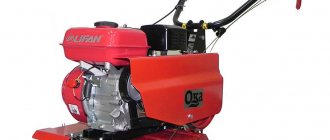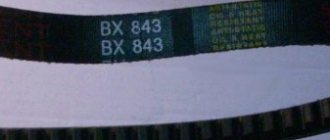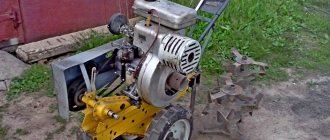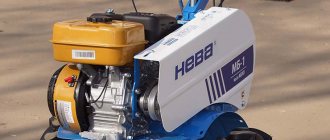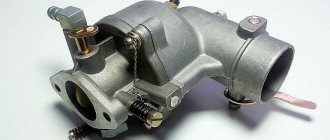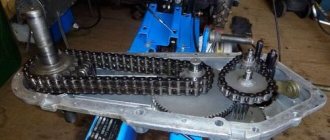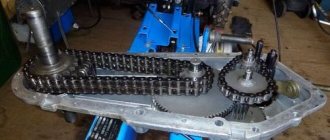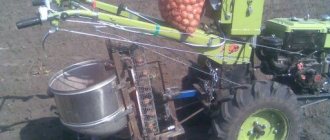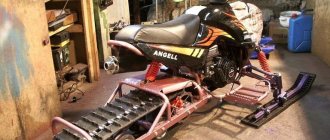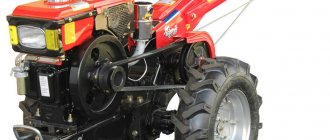Decathlon robe
1299 ₽ More details
Shorts Decathlon
799 ₽ More details
Mittens Decathlon
Correctly selected belt sizes for the Cascade walk-behind tractor are a necessary thing for the mini-tractor to function fully.
Despite the fact that many innovations have been invented so far, farmers continue to face the most common problems that have no solution.
One of these problems is that the belts on walk-behind tractors can fray and break, and therefore they need to be replaced.
This article will describe how to correctly install belts on a Cascade walk-behind tractor, as well as their features.
Monitor the integrity of the belts in the walk-behind tractor
Belt functions
Before moving on to the functions of belts for motor cultivators, you should consider their features.
A mini-tractor such as the Cascade is produced in the city of Perm, and there are not many of their models on the agricultural market. Therefore, maintenance of this unit is not easy. This is due to the fact that parts for the device must be purchased exclusively for one type. Because even the same type of components that are produced by this company, but for different models, are different.
That is why, when choosing components, you must read the instructions and, if possible, consult with specialists.
The functions of components from mini-tractors seem quite simple and insignificant. However, it is this product and its quality that directly determines how well the land will be processed.
Moreover, please note that if the tension is poor and the load is heavy at the same time, the shafts may slip. This means that the tiller will not work.
In this video we will look at replacing the belt in a walk-behind tractor:
Remember that walk-behind tractor manufacturing companies recommend purchasing exclusively V-belts for walk-behind walk-behind tractors from Cascade, so that no problems arise during their operation.
Features of belts for walk-behind tractors Cascade
There are not many models of Perm Cascade walk-behind tractors on the market. And the more difficult it is to maintain this type of equipment, since all components must be selected specifically for a specific type of equipment. After all, even belts from walk-behind tractors of the same company, but of different models, can differ significantly. And such an alternative will result in rapid damage to the part and, possibly, breakdown of the walk-behind tractor itself.
Therefore, when selecting a new belt, it is very important to check the data in the operating instructions and the markings of the old part.
Why do belts wear out?
Many people have never thought about what can cause their straps to wear out. There are quite a lot of reasons. The most common ones are described below:
- During operation of this device, various types of mechanical damage may occur, which can lead to abrasions or cracks.
- Kinks.
- Manufacturing defect. It may be that when checking an agricultural device everything is in order, but in practice the components wear out quickly. In this case, you can replace either the walk-behind tractor or the parts with factory ones.
- Incorrect installation of the installed belts of the Cascade walk-behind tractor.
- Problems with pulley wear.
- Part rupture after engine replacement. Such cases are rare, but they do happen. This problem occurs because the pulleys were not installed parallel and aligned with the groove axis.
Please note that when performing simple work on the site, it is best to loosen the parts. This will help extend the service life.
In order not to repeat the mistakes of the past, it is necessary to understand what exactly led to the breakdown of a particular part.
All about belts for Neva walk-behind tractors
Types of belts on the Neva walk-behind tractor
For the Neva MB-1 walk-behind tractor, 2 V-belt drives are used:
- forward travel;
- reverse.
The MB-2 unit model has a completely different design, where there is one forward belt. Installing a second belt on the Neva walk-behind tractor of this series does not make sense, since reverse gear is carried out directly in the gearbox.
Replacing the reverse belt of MB-1 walk-behind tractors
- remove the casing of the V-belt mechanism;
- remove the rear guide plate of the driven pulley;
- using a wrench, loosen the spring-loaded roller, which is attached to the axis of the reverse belt;
- remove the belt from the driven pulley;
- now you need to pull the new belt onto the driven pulley with the roller;
- We return all the removed parts in the right order and secure them.
Replacing the belt for walk-behind tractors of the MB-2 series
- After removing the shield, remove the protective casing from the pulley.
- In order to loosen the strap, remove the spring from the device's rod.
- Now unscrew the screws that secure the bracket.
- We turn the bracket so that its limiting pins do not prevent you from removing the part from the pulley.
- We draw attention to the non-flatness of the arrangement of the engine shaft pulley grooves. It should not be larger than 1 mm.
- Adjusting the pulleys.
- We install a new part.
- We pull the belt onto the gearbox shaft pulley, and then onto the motor pulley.
- We install all other parts in the reverse order to the right places in the right position.
Replacing drive belts for MB 1 series walk-behind tractors
- We remove the shield and casing of the V-belt mechanism.
- Loosen the pulley bolt and remove the reverse strap.
- Loosen the bolts that secure the bracket.
- Remove the forward strap.
- We install and tension the new parts, secure everything and return all the spare parts to their places.
We have provided you with step-by-step instructions on how to replace a belt for a Neva walk-behind tractor of different models. All this can be easily done with your own hands and without contacting service centers, provided that you are well versed in technology, understand what this or that part is needed for and know where to install it. And even if you are not entirely sure of the correctness of your installation, you should refer to the operating instructions for the walk-behind tractor. Everything should be described there in detail, how and what needs to be done. Use our advice and let your Neva walk-behind tractor or mini tractor work for many years without any problems.
Belt size
Everyone knows that different motor cultivators use components of different lengths and widths.
Below is an example of the size of the belts on the Cascade walk-behind tractor:
- Reverse belt for walk-behind tractor Cascade: A-1400.
- Belt size for forward drive Cascade motor cultivator: A-1180 or A-1213 GOST 1284.
Remember that "A" stands for 13 millimeters.
Based on practice, the forward drive belts of the Cascade walk-behind tractor wear out more. However, when replacing one strap, it is still recommended to change two at the same time. If the device is actively used, the procedure for replacing this element may be approximately once a year.
At the moment, straps for the Cascade motor-cultivator are made from materials such as rubber and polyurethane.
Walk-behind tractor Cascade: replacing belts
To quickly and efficiently make a replacement on the Cascade walk-behind tractor, follow this algorithm:
- Stop the engine and put the gear in neutral.
- Remove the protective cover.
- Remove the old belts.
- Install a new belt. Remove the pulley from the engine, pull the belt onto the gearbox pulley, and reinstall the motor pulley.
- Make sure that it is not twisted and that it is positioned strictly parallel to the grooves of both gearboxes.
- Reinstall the protective cover.
Also, do not forget about the rules for storing and using the product itself to extend its service life. Do not bend or stretch it - this may deform and damage the part. Monitor the condition of the pulley and promptly remove minor defects (scratches, chips, scratches, cracks).
Installation of belts
Installing any components on an agricultural device is not labor-intensive work.
Before you independently replace the belts on the Cascade walk-behind tractor, it is best to read the instructions.
In order to save time and nerves, as well as to correctly replace this component, it is best to use our advice and do everything in order.
- Put the gear in neutral and turn off the engine of the device.
- Turn off the engine.
- Remove the protective cover.
- Remove the belts that you plan to replace. Remember that it is recommended to change all elements at the same time. That is why, when installing reverse belts on a Cascade walk-behind tractor, install them for forward driving as well.
- Supply new components. To do this, you need to remove the pulley. Then the part to be replaced is pulled onto the gear pulley. After which the engine pulley is installed.
- Check whether the belts are positioned correctly on the Cascade walk-behind tractor.
- Reinstall the protective cover.
Observe safety precautions when replacing belts on a walk-behind tractor.
That's all, the components are installed, and the device is ready for use.
Replacement instructions
Replacing belts on a Cascade walk-behind tractor is a simple task and does not require special skills or special tools. The main thing is to follow the instructions, which clearly outline the sequence of actions:
- First, the engine is put in neutral gear and turned off.
- Then the engine is turned off.
- Next, remove the protective casing.
- Remove old damaged rubber rings (for example, stretched ones are cut for convenience). There are two belts on the Cascades, both of which are replaced with new ones at the same time (even if one of them has not yet worn out).
- Install purchased parts. To do this, remove the pulley from the engine, and pull the components onto the gear pulley. After this, the removed element is put back.
- Check the location of pulleys and belts.
- Return the protective casing to its place and secure it.
Recommendations for use
Experienced farmers know that in order to prevent mini-tractor parts from wearing out too often, they need to be used carefully.
Below are some tips for using these parts:
- When purchasing an agricultural device, check it carefully.
- Careful storage and use of the motor cultivator. It is best to carefully read the instructions issued with the unit.
- It is strictly prohibited to bend or pull out parts during storage.
- Do not keep the device in a room with high humidity.
- Periodically check the pulley before use. It would seem an unnecessary thing. However, various defects can cause damage to the element. This means that its service life will not be so long.
- The purchase of any component part should be exclusively from the manufacturer and in trusted stores.
- When purchasing such an item, it is important to check the quality of the product to ensure that there are no defects.
- Also, when replacing one strap, it is best to immediately replace the other. Because if they are replaced at the same time, their condition will be the same, and they will wear out at approximately the same time.
This is interesting: instructions for replacing the belt on an Oka walk-behind tractor.
The size of the belts on the Cascade walk-behind tractor and the procedure for replacing them
Different units use belts of different sizes. Thus, the Cascade walk-behind tractor uses A-1180 or A-1213 GOST 1284 belts for forward travel, and A-1400 belts for reverse travel. The prefix “A” stands for 13 mm.
Before proceeding with removing or replacing the belt, it is necessary to dismantle the protective casing, unscrew the pulley, which has three streams; it is attached with a key and a locking ring to the shaft. When removing the ring you need to be careful not to break it. The material from which it is made is very fragile.
Next, we should move the reverse belt pulley forward to tighten the three-groove pulley, after which we can remove the belt without interference. If it is simply very worn, you can cut it off with a knife.
Next, we check the belts and, if necessary, replace them with exactly the same ones. If there are two of them on the walk-behind tractor, then it is better to replace both of them at once. If you replace only one belt, they will have different degrees of tension, and the new one will take on more load, which will lead to its rapid wear.
We begin to assemble everything in reverse order. We tighten the belts onto the gear pulley, then install the motor pulley, check the tension rollers and make sure that the belts are installed evenly, without distortions. Don't forget to put the protective covers in place and secure them.
